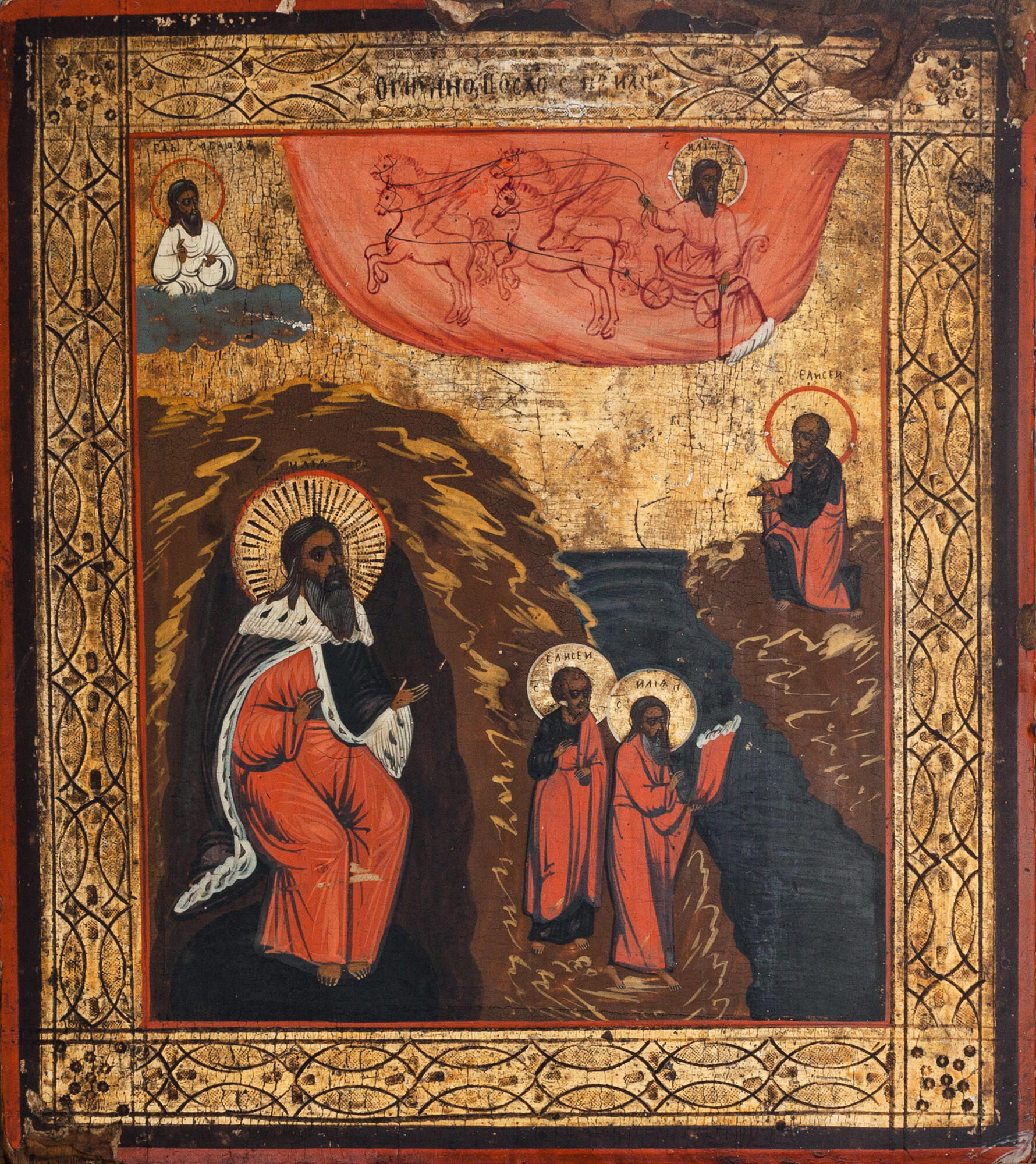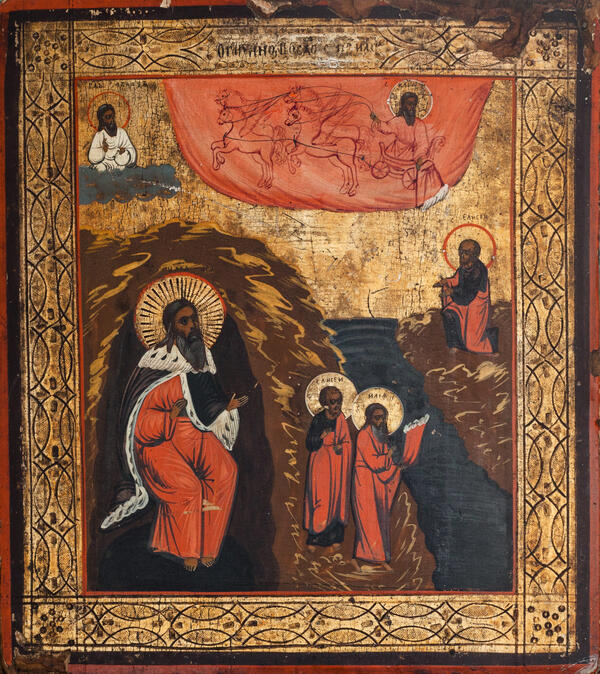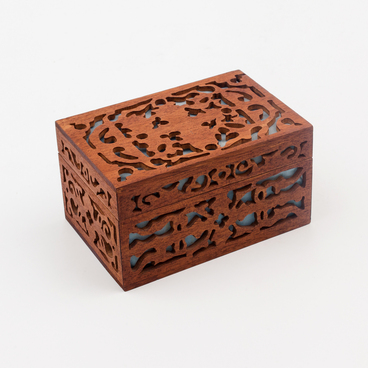The icon ‘The Fiery Ascent of the Prophet Elijah’ is placed in the icon corner of the dining room of the Ulyanovs house. It was donated to Ulyanovsk by the All-Union Vuchetich Artistic Production Association in 1990.
‘The Fiery Ascent of the Prophet Elijah’ was created by an unknown Russian master at the end of the 19th century. He painted the icon on a wooden board in tempera, one of the earliest varieties of water-based paints. A pigment in the form of dry powder, egg yolk, and water was mixed in a container and kneaded well to prepare tempera. A small amount of vinegar or sour kvass (a beverage made from rye bread) was added to make the yolk more liquid. The paint particles were evenly distributed in the obtained mixture. The well-dried thin layer of tempera could not be washed out by the water, could not crack or fall apart into grains.
The Prophet Elijah is one of Russia’s most famous and revered saints, along with Nicholas the Wonderworker.
Elijah was born in Thebes of Gilead in the 9th century B.C. From a young age, he settled in the desert and devoted himself to the service of God — he read prayers, fasted, and kept the commandments. Elijah’s prophetic ministry began when Jezebel, the Phoenician wife of Ahab, the seventh king of Israel, decided to plant the cult of the Phoenician gods Baal and Astarte in the country. She banished all the pious and set up a staff of priests in her court. When the excesses of Ahab and Jezebel became intolerable, the Prophet Elijah told the king that a famine awaited his country, but he would not listen. Later, during a sacrifice that tested the power of the gods Baal and Yahweh, Elijah executed the priests of Baal with his own hands and fled into the desert.
Jews, as well as most Christian denominations, believe that because of his righteous life God called Elijah to heaven alive. The Fourth Book of Kings describes it this way: ‘suddenly there was a chariot of fire and horses of fire, and they parted them both, and Elijah flew in a whirlwind into heaven.’
On the icon, an unknown artist painted not only the ascension of the Prophet himself, but also the scenes that preceded it. Elijah prayed in the cave and then, together with his disciple Elisha, whom he anointed to serve God, went to the river. At the river, a chariot of fire lifted Elijah into heaven, and Elisha was left with only his mantle, the prophet’s cloak. After picking it up, Elisha received a prophetic gift far more powerful than that of his teacher.
Icons of Prophet Elijah were in almost every home. Often his image was mixed with that of the epic hero Ilya Muromets. The people believed that St. Elijah patronized the water element, helped in agriculture, and preserved families.
‘The Fiery Ascent of the Prophet Elijah’ was created by an unknown Russian master at the end of the 19th century. He painted the icon on a wooden board in tempera, one of the earliest varieties of water-based paints. A pigment in the form of dry powder, egg yolk, and water was mixed in a container and kneaded well to prepare tempera. A small amount of vinegar or sour kvass (a beverage made from rye bread) was added to make the yolk more liquid. The paint particles were evenly distributed in the obtained mixture. The well-dried thin layer of tempera could not be washed out by the water, could not crack or fall apart into grains.
The Prophet Elijah is one of Russia’s most famous and revered saints, along with Nicholas the Wonderworker.
Elijah was born in Thebes of Gilead in the 9th century B.C. From a young age, he settled in the desert and devoted himself to the service of God — he read prayers, fasted, and kept the commandments. Elijah’s prophetic ministry began when Jezebel, the Phoenician wife of Ahab, the seventh king of Israel, decided to plant the cult of the Phoenician gods Baal and Astarte in the country. She banished all the pious and set up a staff of priests in her court. When the excesses of Ahab and Jezebel became intolerable, the Prophet Elijah told the king that a famine awaited his country, but he would not listen. Later, during a sacrifice that tested the power of the gods Baal and Yahweh, Elijah executed the priests of Baal with his own hands and fled into the desert.
Jews, as well as most Christian denominations, believe that because of his righteous life God called Elijah to heaven alive. The Fourth Book of Kings describes it this way: ‘suddenly there was a chariot of fire and horses of fire, and they parted them both, and Elijah flew in a whirlwind into heaven.’
On the icon, an unknown artist painted not only the ascension of the Prophet himself, but also the scenes that preceded it. Elijah prayed in the cave and then, together with his disciple Elisha, whom he anointed to serve God, went to the river. At the river, a chariot of fire lifted Elijah into heaven, and Elisha was left with only his mantle, the prophet’s cloak. After picking it up, Elisha received a prophetic gift far more powerful than that of his teacher.
Icons of Prophet Elijah were in almost every home. Often his image was mixed with that of the epic hero Ilya Muromets. The people believed that St. Elijah patronized the water element, helped in agriculture, and preserved families.



